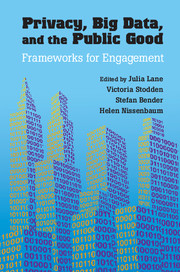14 - Differential Privacy: A Cryptographic Approach to Private Data Analysis
Published online by Cambridge University Press: 05 July 2014
Summary
Introduction
Propose. Break. Propose again. So pre-modern cryptography cycled. An encryption scheme was proposed; a cryptanalyst broke it; a modification, or even a completely new scheme, was proposed. Nothing ensured that the new scheme would in any sense be better than the old. Among the astonishing breakthroughs of modern cryptography is the methodology of rigorously defining the goal of a cryptographic primitive – what it means to break the primitive – and providing a clear delineation of the power – information, computational ability – of the adversary to be resisted (Goldwasser and Micali 1984; Goldwasser et al. 1988). Then, for any proposed method, one proves that no adversary of the specified class can break the primitive. If the class of adversaries captures all feasible adversaries, the scheme can be considered to achieve the stated goal.
This does not mean the scheme is invulnerable, as the goal may have been too weak to capture the full demands placed on the primitive. For example, when the cryptosystem needs to be secure against a passive eavesdropper the requirements are weaker than when the cryptosystem needs to be secure against an active adversary that can determine whether or not arbitrary ciphertexts are well formed (such an attack was successfully launched against PKCS#1; Bleichenbacher 1998). In this case the goal may be reformulated to be strictly more stringent than the original goal, and a new system proposed (and proved). This strengthening of the goal converts the propose–break–propose again cycle into a path of progress.
- Type
- Chapter
- Information
- Privacy, Big Data, and the Public GoodFrameworks for Engagement, pp. 296 - 322Publisher: Cambridge University PressPrint publication year: 2014
References
- 6
- Cited by



